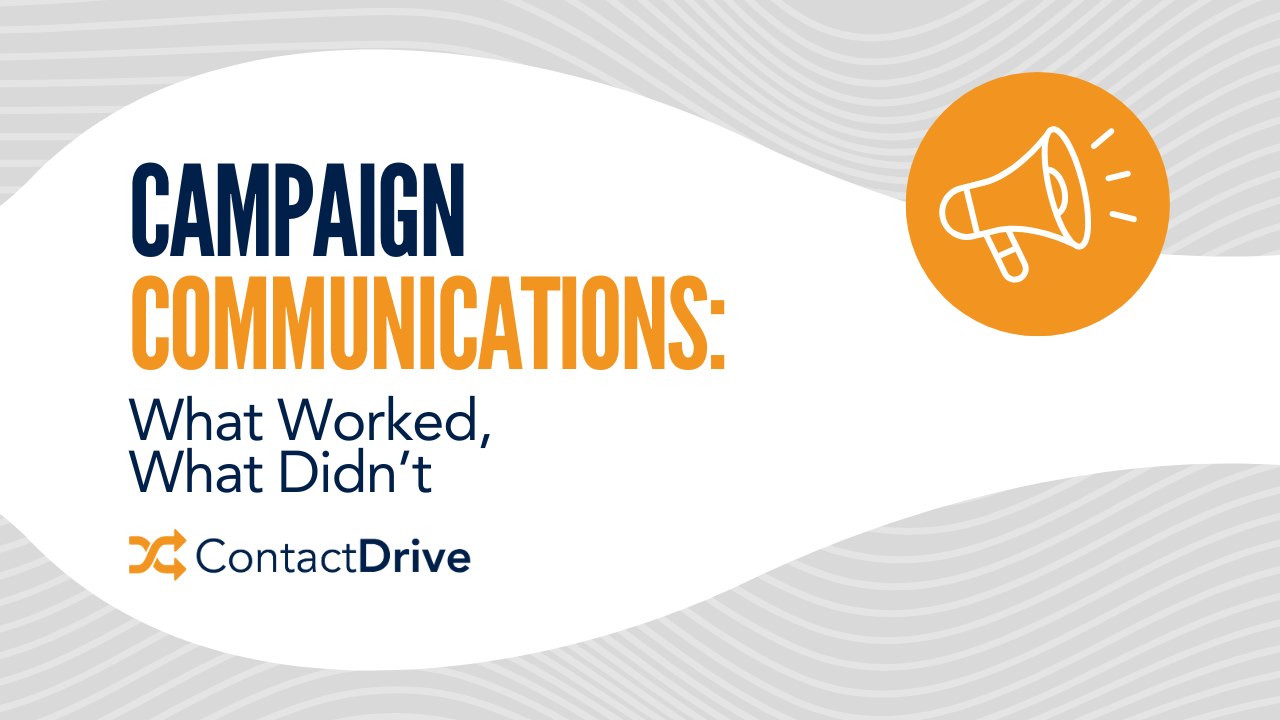As the dust settles after another election cycle it’s important to take an honest look at what worked in campaign communications — and what didn’t.
Campaigns provide a unique testing ground for strategies that can translate far beyond politics into business and life in general. Here are the big takeaways we noticed from the hundreds of organizations using ContactDrive in the 2024 election, and what it means moving forward.
What Campaigns Got Right: The Power of Personal, One-to-One Communication
The standout success of this election cycle? The undeniable impact of personalized, one-to-one communication. Whether it was through relational organizing, aggressive field programs, community events, or coalition outreach, campaigns that focused on building authentic relationships with voters reaped the benefits.
Why does this approach work so well? Because in our increasingly digital era, people respond best to trusted, personal connections. Specifically, we saw the impact of relational organizing and its power to personalize the election down from big, national themes to shared community concerns.
In an era increasingly known for nationalized campaigns and billions in advertising, when a neighbor knocks on your door or shoots you a text, it makes it personal — and local — very quickly.
Another voter contact method that leveraged trust to break through was coalition outreach. Rather than vacuuming up every email address in sight, winning battleground campaigns built connections with allied organizations who could encourage their own lists of supporters to get active. Again, it comes down to trust. Voters who already had a trusted relationship with an organization were easier to reach and persuade through that organization.
Hyper-local events also played a role in building local communities of support. Organizations provided “house party kits” to local grassroots leaders, giving them the perfect tool to recruit neighbors to get involved.
Key Takeaways:
- Make it personal: Whether you’re reaching out to a voter, a donor, a client, or a prospect, customize your approach. Reference their specific needs, recent milestones, or shared experiences. Communicating in context is critical.
- Be consistent: Successful campaigns didn’t stop at one interaction — they followed up. Building trust takes time, and consistency is key.
- Use the right tools: Smart campaigns relied on tools like CRMs to manage their outreach. A good relationship management system can ensure no one slips through the cracks.
What Campaigns Missed: Why Mass Media Blasts Don’t Work
Despite billions spent on advertising this cycle, the impact of mass media blasts — whether TV ads, non-personalized texts, or email campaigns — proved underwhelming. Voters are increasingly tuning out noise that doesn’t feel relevant to them. The more generic the message, the less likely it is to stick.
For example, President Donald J. Trump’s campaign relied on an aggressive, sustained, generic SMS fundraising campaign over the last several years, but it failed to deliver. Despite winning the election, President Trump’s campaign apparatus saw a dramatic drop in small dollar donations, from $378 million in 2020 (49% of total fundraising) to $109 million in 2024 (representing just 29% of total fundraising).
Mass communication has its place, but it can’t replace authentic, meaningful interactions. Campaigns that leaned too heavily on impersonal communication missed opportunities to connect with voters on a deeper level.
Key Takeaways:
- Focus on quality over quantity: Bombarding your network with generic updates or promotions can backfire. Instead, prioritize thoughtful, targeted messages.
- Don’t over-rely on automation: Automation can help scale efforts, but it shouldn’t replace the human touch. Find ways to blend efficiency with personalization.
- Meet people where they are: Your connections have preferences for how they want to be engaged. Whether it’s a quick phone call or a personalized email, adapt your outreach to their needs.
Why This Matters Beyond Campaigns
The lessons from campaigns resonate well outside the political world. Whether you’re running a small business, managing a team, or building your personal network, the same principles apply. Even years after the COVID-19 lockdowns, people are still trying to figure out how to rebuild connection, and those who invest in meaningful, intentional communication will see stronger results.
In the post-election world, the takeaway is clear: the future of communication is personal. It’s not about shouting louder; it’s about listening more closely. It’s not about reaching more people; it’s about truly connecting with the ones who matter most and mobilizing that coalition of inspired, engaged supporters to help you grow.
By focusing on one-to-one interactions and avoiding the pitfalls of impersonal mass messaging, we can all build stronger, more impactful relationships — whether we’re running a campaign, leading a business, or simply trying to make our corner of the world a little better.
How ContactDrive Can Help
ContactDrive has been a trusted partner for campaigns and businesses nationwide, helping them build authentic connections through powerful tools like advanced contact segmentation and seamless integrations. Whether you’re reconnecting with clients, managing customer relationships, or growing your professional network, ContactDrive is here to help you foster the personal, one-to-one connections that truly drive success. Try it out for free!

